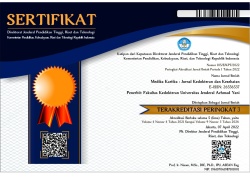PAROSMIA SEBAGAI GEJALA LANJUT COVID-19 : LAPORAN KASUS
Abstract
Parosmia atau distorsi fungsi penciuman adalah gangguan penghidu/penciuman yang membuat seseorang merasa membau secara berbeda dari yang seharusnya. Parosmia akhir-akhir ini dikenal sebagai salah satu gejala lanjutan dari COVID-19 atau sering disebut juga sebagai long covid. Prevalensi pasti kejadian parosmia sebagai lanjutan gejala COVID-19 masih belum jelas diketahui karena masih sedikitnya pelaporan dan tidak semua penderita datang berobat. Penelitian ini melaporkan 3 kasus parosmia yang datang ke poliklinik THT RS Dustira. Tujuan penelitian ini adalah untuk menilai karakteristik pasien dan hasil dari pengobatan parosmia sebagai gejala lanjutan COVID-19. Dari 3 pasien yang mengalami parosmia, jenis kelamin lakilaki 2 orang dan perempuan 1 orang. Usia pasien 30, 32 dan 40 tahun. Dua orang pasien merupakan perokok. Ketiga pasien didiagnosis COVID-19 3-5 bulan yang lalu dan semua disertai gejala hidung seperti anosmia, hidung beringus dan hidung tersumbat. Dua pasien mengalami dysgeusia. Keluhan yang dirasakan berupa sensasi mencium bau busuk pada satu orang dan dua orang mencium bau karat. Tatalaksana yang diberikan berupa irigasi nasal salin dan latihan penghidu (olfactory training). Respon pengobatan pada ketiga pasien dalam rentang waktu pengobatan 3 bulan berupa hilangnya gejala pada satu orang dan tidak berespon pada 2 orang. Parosmia adalah gejala yang dapat terjadi paska infeksi COVID-19. Tatalaksana dengan irigasi nasal salin dan latihan penghidu memberikan perbaikan pada sebagian pasien walaupun dengan respon yang lambat. Masih diperlukan penelitian lebih lajut untuk menentukan pencegahan dan tatalaksana parosmia.
Kata kunci : COVID-19, long covid, parosmia, penghidu
DOI : 10.35990/mk.v7n0.p14-25
References
Bhutani S, Pellegrino R, Tsukahara T et
al.: COVID-19 and the chemical senses:
supporting players take center stage.
Neuron 2020; 107:219-233
2. Moein S, Hashemian S, Mansourafshar
B, Khorram- Tousi A, Tabarsi P, Doty
RL: Smell dysfunction: a biomarker for
COVID-19. International forum of
allergy & rhinology 2020; 10:944-950
3. Strauss S, Lantos J, Heier L, Shatzkes
D, Phillips C: Olfactory bulb signal
abnormality in patients with COVID-19
who present with neurologic symptoms.
Nurrokhmawati, Y : Parosmia Sebagai Gejala Lanjut COVID-19 : Laporan Kasus
MK | Edisi PIT | FK UNJANI 23
AJNR. American journal of
neuroradiology 2020; 41:1882-1887
4. Kandemirli S, Altundag A, Yildirim D,
Tekcan Sanli D, Saatci O: Olfactory
bulb MRI and paranasal sinus CT
findings in persistent COVID-19
anosmia. Academic radiology 2021;
28:28-35
5. Brann D, Tsukahara T, Weinreb C,
Lipovsek M, Van den Berge K, Gong B
et al.: Non-neuronal expression of
SARS-CoV-2 entry genes in the
olfactory system suggests mechanisms
underlying COVID-19-associated
anosmia. Science Advances 2020;
6:eabc5801
6. Parma V, Ohla K, Veldhuizen M, Niv
M, Kelly C, Bakke A et al.: More than
smell-COVID-19 is associated with
severe impairment of smell, taste, and
chemesthesis. Chemical Senses 2020;
45:609-622
7. Gerkin R, Ohla K, Veldhuizen M.:
Recent smell loss is the best predictor of
COVID-19 among individuals with
recent respiratory symptoms. Chem
Senses 2021; 46:bjaa081.
doi:10.1093/chemse/bjaa081.
PMID:33367502;
PMCID:PMC7799216
8. Saniasiaya J, Narayanan Parosmia post
COVID-19: an unpleasant
manifestation of long COVID
syndrome . Postgrad Med J 2021;0:1.
doi:10.1136/postgradmedj-2021-
139855
9. Stenner M, Vent J, Hüttenbrink K-B, et
al. Topical therapy in anosmia:
relevance of steroid- responsiveness.
Laryngoscope 2008;118:1681–6.
10. Butowt R, von Bartheld C. Anosmia in
COVID-19: underlying mechanisms
and assessment of an olfactory route to
brain infection. Neuroscientist
2020;11:107385842095690.
11. Gane S, Kelly C, Hopkins C. Isolated
sudden onset anosmia in COVID-19
infection. A novel syndrome. Rhinology
2020;58:289–94.
12. Hummel T, Whitcroft KL, Andrews P,
Altundag A, Cinghi C, Costanzo RM et
al.: Position Paper on Olfactory
Dysfunction. Rhinology. Supplement
54(26), Article 26
13. Svetlana Kopishinskaia, Daria
Lapshova, Mikhail Sherman, Ivan
Velichko, Nikolai Voznesensky & Vera
Voznesenskaia: Clinical Features In
Russian Patients With CovidAssociated Parosmia/Phanthosmia
Psychiatria Danubina, 2021; Vol. 33,
Suppl. 9, pp 130-136
14. Liu T, Sabha M, Damm M, Philpott C,
Oleszkiewicz A, Hähner A, Hummel T.
Parosmia is Associated with Relevant
Olfactory Recovery After Olfactory
Training. Laryngoscope 2021; 131:
618-623.
MK | Edisi PIT | FK UNJANI
Nurrokhmawati, Y : Parosmia Sebagai Gejala Lanjut COVID-19 : Laporan Kasus
24
15. Reden J, Maroldt H, Fritz A, Zahnert T,
Hummel T. A study on the prognostic
significance of qualitative olfactory
dysfunction. Eur Arch
Otorhinolaryngol 2007; 264: 139-144.
12.
16. Carfì A, Bernabei R, Landi F, et al.
Persistent symptoms in patients after
acute COVID-19. JAMA
2020;324:603–5.
17. Ohla K, Veldhuizen, Green, Hannum
M. Bakke A, Moein S et al. Increasing
incidence of parosmia and phantosmia
in patients recovering from COVID-19
smell loss. National Institutes of Health/
NINR/NIAAA, USA
https://doi.org/10.1101/2021.08.28.212
62763; this version posted August 31,
2021
18. Khalifah W, Damanhouri B, Abushal B,
et al. (November 26, 2021) Persistent
Parosmia Caused By COVID-19
Infection: An Emerging Symptom.
Cureus 13(11): e19921. DOI
10.7759/cureus.19921
19. Rashid R, Alaqeedy A, Al-Ani A.
Parosmia Due to COVID-19 Disease: A
268 Case Series Indian Journal of
Otolaryngology and Head & Neck
Surgery, May 2021
DOI:10.1007/s12070-021-02630-9
20. Nurrokhmawati Y, Gambaran
Gangguan penghidu pada pasien covid19 di RS Dustira Cimahi, Research
Paper and poster, PIN IDI Jabar 2021
21. Hummel T, Lotsch J. Prognostic
factors of olfactory dysfunction. Arch
Otolaryngol Head Neck Surg 2010;
136: 347-351.
22. Mercante G, Ferreli F, De Virgilio A, et
al. Prevalence of Taste and Smell
Dysfunction in Coronavirus Disease
2019. JAMA Otolaryngol Head Neck
Surg 2020; 146: 723-728.
23. Ralli M, Di Stadio A, Greco A et al.
Defining the burden of olfactory
dysfunction in COVID-19 patients. Eur
Rev Med Pharmacol Sci 2020; 24:
3440-3441
24. Whitcroft K, Hummel T. Olfactory
Dysfunction in COVID-19: Diagnosis
and Management. JAMA 2020; 323:
2512-2514.
25. Levy J. Treatment Recommendations
for Persistent Smell and Taste
Dysfunction Following COVID-19-The
Coming Deluge. JAMA Otolaryngol
Head Neck Surg 2020; 146: 733.
26. Graziadei P, Levine R, Monti Graziadei
G. Plasticity of connections of the
olfactory sensory neuron: regeneration
into the forebrain following bulbectomy
in the neonatal mouse. Neuroscience
2004 ;4:713–27.
27. Wardani R, Ratunanda S, Sutikno B,
Mailasari A Gangguan Penghidu Dan
Pengecap pada COVID-19 Buku
Nurrokhmawati, Y : Parosmia Sebagai Gejala Lanjut COVID-19 : Laporan Kasus
MK | Edisi PIT | FK UNJANI 25
pedoman tatalaksana di bidang THTKL Selama Pandemi COVID-19
Volume 2. PERHATI-KL INDONESIA
2020; 47-50
28. Hopkins C, Alanin M, Philpott C, et al.:
Management of new onset loss of sense
of smell during the COVID- 19
pandemic - BRS Consensus Guidelines.
Clin Otolaryngol. 2021, 46:16-22.
10.1111/coa.13636
29. Borsetto D, Hopkins C, Philips V,
Obholzer R, Tirelli G, Polesel J,
Boscolo-Rizzo P. Self-reported
alteration of sense of smell or taste in
patients with COVID-19: a systematic
review and meta-analysis on 3563
patients. Rhinology 2020; 58: 430-436.
30. Gottfried, J. Central mechanisms of
odour object perception. Nat Rev
Neurosci 2010; 11: 628-641.



























